Chicago Murals Celebrating Women: Fighting Erasure and Marginalization through Public Art
16 January 2024 – Michelle Duster
The United States has a long history of banning, erasing, or marginalizing African American people and history from books, curricula, public spaces, institutions, and representation in art. Huge swaths of information and entire communities have been grossly underrepresented in art galleries, museums, and public artwork. At approximately twelve percent of the general population, African Americans are represented in less than five percent of public art. And the few images of African Americans tend to be located in predominantly Black neighborhoods versus central areas. This is the case in Chicago.
Meanwhile, the vast majority of highly visible artwork depicts White men even though they are only thirty percent of the population. According to a study by Monument Lab, which defines a monument as a “statement of power and presence in public,” the majority of sculptures, plaques, and public artworks depict White male military leaders, wealthy land owners, or racial oppressors.
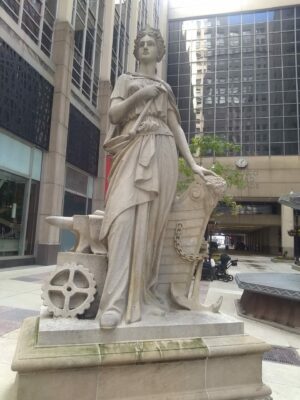
Statue of Industry (pictured) and Statue of Agriculture, sculptor unknown, created circa 1885 (per plaque at site), located in plaza near Board of Trade Building at 333 S. LaSalle. Credit: Michelle Duster.
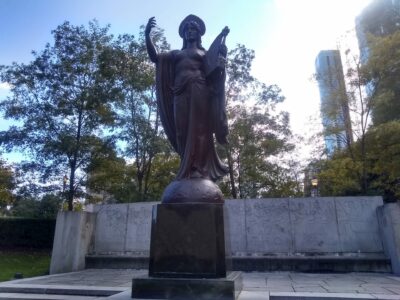
The Spirit of Music statue at Theodore Thomas Memorial, by Albin Polasek, installed 1923 in Grant Park near Michigan Avenue and Balbo. Credit: Michelle Duster.
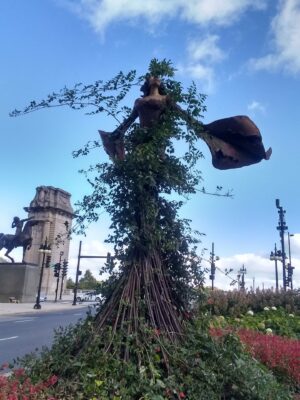
Magdalene by Dessa Kirk, installed 2005 at intersection of Ida B. Wells Drive and Michigan Avenue. Credit: Michelle Duster.
Chicago Monuments Project has identified several dozen of its 500 public art pieces as problematic when it comes to the skewing of history. Not only are people who worked for peace rarely depicted, but women and people of color represent only a small percentage of the images in public spaces.
Despite the strides that women have made in political, business, judicial, and other forms of leadership on local and national levels, when it comes to public artwork, the majority find depiction in the form of a goddess, fictional characters, or generic or composite figures.
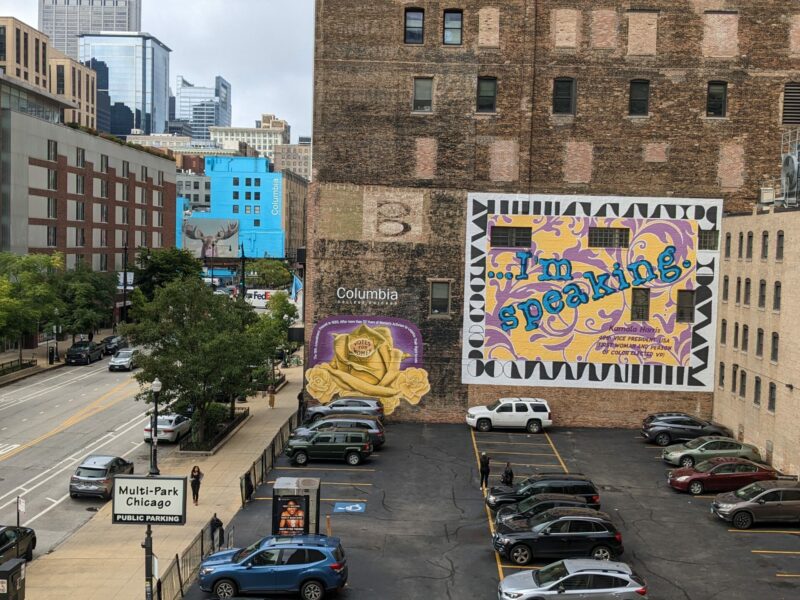
Speak Up! by Dorian Sylvain and Votes for Women by AB Productions, located at 623 S. Wabash. The blue wall on the left side of image is where On the Wings of Change is installed. Credit: Michelle Duster.
Before 2017, there were no significant depictions of real historical women in downtown Chicago in the form of public art. Kerry James Marshall changed that when he created a large-scale mural with images of twenty real women. Three years later in 2020, six activists formed the Chicago Womxn’s Suffrage Tribute Committee (CWSTC), working with the Wabash Arts Corridor to create murals that feature a racially diverse group of local suffragists and connect their work to achievements of today’s women.
CWSTC commissioned artist Diosa (Jasmina Cazacu) to create a large-scale mural for a highly-visible and highly-trafficked downtown area to add to the small number of female images in the city’s public spaces. In 2021, they installed the seven-story mural On the Wings of Change featuring portraits of ten local suffrage leaders, three of whom were African American.
They also commissioned a second text-based mural, Speak Up!, created by Dorian Sylvain, which responded to the phrase, “I’m speaking…”–a statement made repeatedly by Vice President Kamala Harris during the 2020 vice presidential debate. Their vision was to position the two murals perpendicular to each other, and to connect the passage the 19th Amendment in 1920 to Harris’s election exactly one hundred years later.
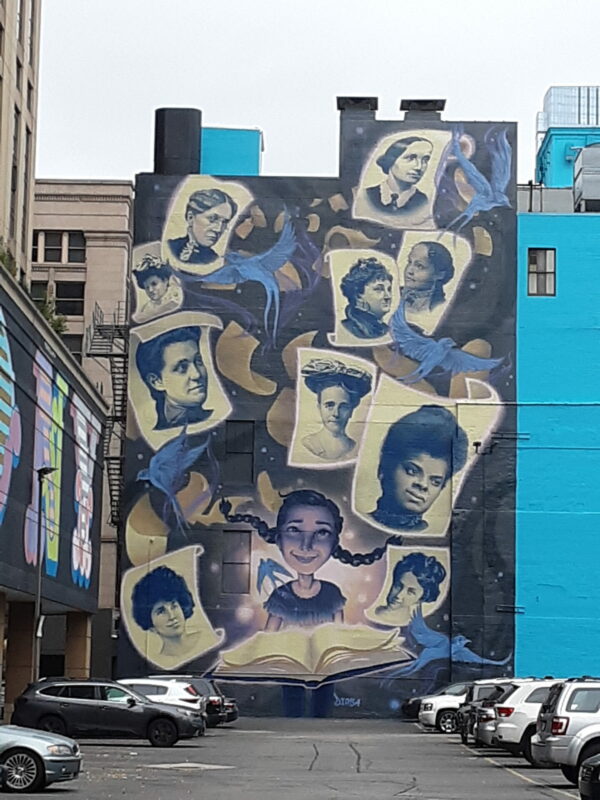
On the Wings of Change by Diosa (Jasmina Cazacu) located at 33 E. Ida B. Wells Drive (near Wabash and Harrison). Credit: Michelle Duster.
The artwork was meant to add representation of real women in the central part of Chicago. However, the opportunity to add gender equity was met with resistance by the White male owner of the parking lot adjacent to the wall. He refused to rent the parking spaces where the lifts that would be used to install the mural needed to be placed. Committee members and project stakeholders made numerous efforts to help him see how the artwork would be an additive feature to the area. But he was unrelenting in his obstinance and single-handedly stopped the installation of artwork commissioned by six women to document a woman’s history-making achievement.
This serves as an example of how challenging it is to address White male domination of public space. In some cases, the resistance and interference continue after work has been installed. For example: two murals in Chicago of beloved Black male musicians Frankie Knuckles and Juice WRLD were painted over, Black Lives Matter murals in several cities have been defaced, and a Black history mural at Washington University in St. Louis, as well as a Black Panthers mural in Los Angeles, CA have also recently seen defacement. Some historical markers that celebrate African Americans, including Jackie Robinson, have even been riddled with bullets. The Emmett Till marker in Tallahatchie County, Mississippi has been vandalized and shot at so many times that a bulletproof version had to be installed in 2019.
Despite the increasing hostility toward women and marginalized groups, CWSTC members were determined to complete their project. Once it had become apparent that it would take extraordinary effort to gain access to the original site, they refocused their energy and lobbied for alternate sites. Two years later, they secured a different, smaller wall in close proximity to their first choice, and the artist agreed to revise her design to suit the location. The committee decided to fill the remaining space by commissioning a third mural, Votes for Women by AB Productions, which features the yellow rose and titular phrase, a slogan used during the suffrage movement. In order to ensure that the two new murals complemented On the Wings of Change, a similar color scheme was chosen incorporating purple, yellow, and white–popular colors of the suffrage movement. The result is a deliberate nod to that history as well as purposeful continuity between all three pieces that serve as a set.
Today, when people are in the South Loop walking north from 700 South Wabash, they will see all three south-facing murals in close proximity: Speak Up! and Votes for Women on the east side of the street, and On the Wings of Change on the west side just a few yards away. The three murals work together to construct a narrative of the suffrage movement.
Importantly, the completion of these large-scale projects demonstrates how resistance to the representation of African American women in public spaces will be met with equal determination to make them seen. The murals say that Chicago-based activist women–both past and present–are speaking.
~Michelle Duster is an educator and activist whose advocacy has led to street names, monuments, historical markers, and other public history projects. She is a member of CWSTC and the author of several books, including Ida B. the Queen: The Extraordinary Life and Legacy of Ida B. Wells (2021) and Ida B. Wells, Voice of Truth (2022) which are about her paternal great-grandmother.



